The healthcare AI computer vision market is expected to grow from USD 558.9 million in 2025 to USD 1,489.7 million by 2035, advancing at a CAGR of 10.3%. Saturation point analysis highlights stages where market growth may plateau due to widespread adoption and the fulfillment of primary demand. From 2025 to 2028, the market is in an early adoption phase, driven by hospitals, diagnostic centers, and research facilities integrating AI-powered imaging solutions for disease detection, workflow optimization, and clinical decision support. Increasing awareness of AI capabilities, coupled with regulatory approvals, accelerates adoption, keeping the market well below saturation.
From 2028 to 2032, the market experiences rapid growth as larger healthcare networks, imaging service providers, and specialty clinics expand deployment of computer vision applications for radiology, pathology, and ophthalmology. Technological enhancements, including higher accuracy, reduced processing times, and integration with electronic health records, push adoption rates higher. By 2032 to 2035, the market approaches a saturation point in mature regions where most hospitals and clinics have implemented AI solutions, and future growth is driven primarily by software updates, hardware upgrades, and penetration into emerging markets.
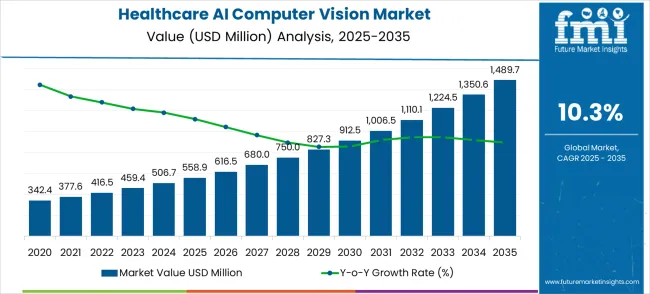
| Metric | Value |
|---|---|
| Market Value (2025) | USD 558.9 million |
| Market Forecast (2035) | USD 1,489.7 million |
| Growth Rate | 10.3% CAGR |
| Leading Deployment Model | Cloud-Based |
| Primary Application | Medical Imaging and Diagnosis |
The healthcare AI computer vision market is segmented across diagnostic imaging and radiology (40%), surgical assistance and robotics (25%), pathology and laboratory analysis (15%), patient monitoring and telemedicine (12%), and specialty applications including dermatology and ophthalmology (8%). Diagnostic imaging leads adoption due to AI computer vision’s ability to enhance accuracy, speed, and early detection in X-rays, CT scans, and MRI analyses. Surgical assistance uses AI-driven vision for precision guidance in minimally invasive procedures. Pathology and laboratory workflows leverage AI for automated sample analysis and anomaly detection. Patient monitoring and telemedicine integrate AI vision to detect vital signs and movement patterns remotely. Specialty applications focus on skin lesion analysis, retinal scans, and other targeted diagnostic tasks.
Emerging trends include deep learning algorithms, real-time image interpretation, and integration with electronic health records (EHRs). Manufacturers are innovating with cloud-enabled platforms, edge computing solutions, and explainable AI models. Growth is driven by digital health adoption, demand for early diagnosis, and precision medicine initiatives. Collaborations between AI technology providers and healthcare institutions enable customized, accurate, and scalable solutions, supporting sustained global market expansion.
Market expansion rests on three fundamental shifts driving adoption across healthcare and medical sectors. Diagnostic accuracy demand creates compelling operational advantages through AI computer vision systems that provide immediate diagnostic assistance without human error risks, enabling medical professionals to identify conditions earlier while maintaining diagnostic superiority and reducing misdiagnosis risks. Healthcare digitization programs accelerate as medical facilities worldwide seek advanced AI-powered systems that complement traditional diagnostic methods, enabling precise medical imaging analysis and patient monitoring applications that align with healthcare standards and regulatory requirements. Medical infrastructure enhancement drives adoption from hospitals and diagnostic centers requiring effective imaging analysis tools that minimize interpretation errors while maintaining patient care quality during complex diagnostic procedures and treatment planning.
The growth faces headwinds from regulatory compliance challenges that vary across jurisdictions regarding the deployment of AI diagnostic systems and patient data privacy protocols, which may limit operational flexibility in certain healthcare environments. Technical limitations also persist regarding diagnostic accuracy and integration complexity that may reduce system performance with legacy medical equipment or non-standardized imaging formats that limit AI processing capabilities.
The healthcare AI computer vision market represents a transformative growth opportunity, expanding from USD 558.9 million in 2025 to USD 1.49 billion by 2035 at a 10.3% CAGR. As healthcare systems worldwide prioritize diagnostic accuracy, operational efficiency, and patient safety, AI computer vision has evolved from experimental technology to mission-critical infrastructure enabling early disease detection, reducing diagnostic errors, and supporting clinical decision-making across radiology, pathology, and surgical applications.
The convergence of healthcare digitization mandates, aging populations requiring advanced diagnostics, cloud computing maturation, and regulatory acceptance of AI medical devices creates unprecedented adoption momentum. Advanced diagnostic algorithms offering superior accuracy, seamless EHR integration, and regulatory compliance will capture premium market positioning, while geographic expansion into emerging healthcare markets and scalable cloud deployment will drive volume leadership. Government healthcare modernization programs and medical device standardization provide structural support.
Primary Classification: The market segments by deployment model into Cloud-Based and On-Premise categories, representing the evolution from traditional on-site installations to scalable cloud-based solutions for comprehensive healthcare coverage.
Secondary Breakdown: Application segmentation divides the market into Medical Imaging and Diagnosis, Surgery, Hospital Management, and Other sectors, reflecting distinct requirements for diagnostic support, surgical assistance, administrative automation, and specialized medical applications.
Regional Classification: Geographic distribution covers North America, Europe, Asia Pacific, Latin America, and the Middle East & Africa, with developed markets leading adoption while emerging economies show accelerating growth patterns driven by healthcare modernization programs.
The segmentation structure reveals technology progression from traditional on-premise systems toward integrated cloud-based platforms with enhanced scalability and accessibility capabilities, while application diversity spans from medical imaging diagnostics to comprehensive hospital management solutions requiring precise AI-powered healthcare assistance.
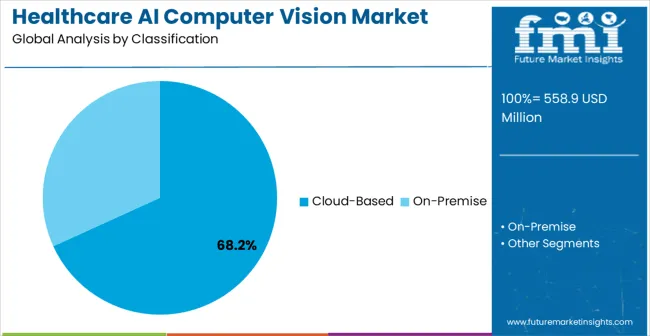
Market Position: Cloud-based deployment systems command the leading position in the Healthcare AI Computer Vision market with approximately 68.2% market share through advanced scalability features, including cost-effective implementation, remote accessibility, and automatic software updates that enable healthcare facilities to deploy AI computer vision capabilities across diverse medical environments without significant infrastructure investments.
Value Drivers: The segment benefits from healthcare provider preference for scalable deployment systems that provide immediate diagnostic capabilities without requiring extensive on-site hardware installation or IT infrastructure support. Cloud-based design features enable deployment in small clinics, large hospitals, and telemedicine applications where scalability and cost-effectiveness represent critical operational requirements.
Competitive Advantages: Cloud-based systems differentiate through rapid deployment capability, automatic updates, and integration with existing healthcare information systems that enhance medical professional effectiveness while maintaining cost-effective operational profiles suitable for healthcare facilities of all sizes.
Key market characteristics:
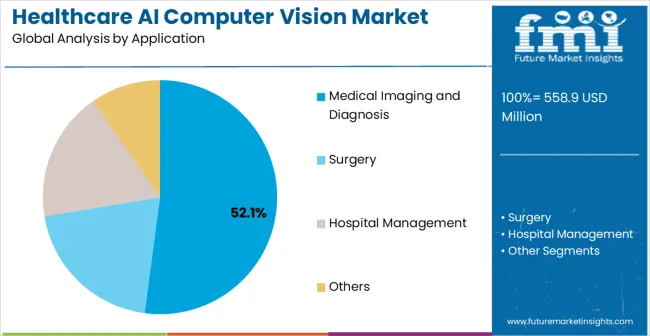
Market Context: Medical Imaging and Diagnosis applications dominate the Healthcare AI Computer Vision market with approximately 52.1% market share due to widespread adoption of AI-powered diagnostic systems and increasing focus on early disease detection, radiological analysis, and pathological diagnosis applications that minimize diagnostic errors while maintaining clinical effectiveness.
Appeal Factors: Healthcare customers prioritize system accuracy, regulatory compliance, and integration with existing medical imaging infrastructure that enables coordinated diagnosis across multiple medical specialties. The segment benefits from substantial healthcare budgets and modernization programs that emphasize AI diagnostic tool acquisition for improved patient outcomes and operational efficiency.
Growth Drivers: Healthcare digitization programs incorporate AI computer vision as standard equipment for medical imaging analysis and diagnostic support applications. At the same time, increasing medical imaging volumes are driving demand for AI-powered diagnostic capabilities that comply with healthcare regulations and minimize diagnostic errors.
Market Challenges: Regulatory compliance requirements and medical device approval processes may limit system deployment in certain healthcare environments or diagnostic scenarios.
Application dynamics include:
Growth Accelerators: Healthcare digitization drives primary adoption as AI computer vision systems provide diagnostic assistance capabilities that enable accurate medical imaging analysis without human error risks, supporting clinical decision-making and diagnostic accuracy missions that require precise medical interpretation. The demand for medical infrastructure accelerates market expansion as healthcare providers seek effective diagnostic enhancement tools that minimize interpretation errors while maintaining clinical effectiveness during complex medical procedures and patient care scenarios. Healthcare spending increases worldwide, creating sustained demand for AI-powered diagnostic systems that complement traditional medical equipment and provide clinical flexibility in complex healthcare environments.
Growth Inhibitors: Regulatory compliance challenges vary across jurisdictions regarding the deployment of AI diagnostic systems and patient data privacy protocols, which may limit operational flexibility and market penetration in regions with restrictive healthcare technology regulations. Technical performance limitations persist regarding diagnostic accuracy and system integration that may reduce effectiveness with legacy medical equipment, non-standardized imaging formats, or complex clinical workflows that limit AI processing capabilities. Market fragmentation across multiple healthcare standards and regulatory requirements creates compatibility concerns between different AI system providers and the existing medical infrastructure.
Market Evolution Patterns: Adoption accelerates in healthcare and medical sectors where diagnostic accuracy justifies system costs, with geographic concentration in developed markets transitioning toward mainstream adoption in emerging economies driven by healthcare modernization and medical infrastructure development. Technology development focuses on enhanced diagnostic accuracy, improved integration capabilities, and compatibility with diverse medical imaging systems that optimize clinical workflow and diagnostic effectiveness. The market could face disruption if alternative diagnostic technologies or regulatory restrictions significantly limit AI computer vision deployment in clinical or medical applications.
The Healthcare AI Computer Vision market demonstrates varied regional dynamics with Growth Leaders including China (13.9% CAGR) and India (12.9% CAGR) driving expansion through healthcare digitization and medical infrastructure development. Steady Performers encompass Germany (11.8% CAGR), Brazil (10.8% CAGR), and the USA (9.8% CAGR), benefiting from established healthcare industries and advanced medical technology adoption. Emerging Markets feature the UK (8.8% CAGR) and Japan (7.7% CAGR), where specialized healthcare applications and medical technology integration support consistent growth patterns.
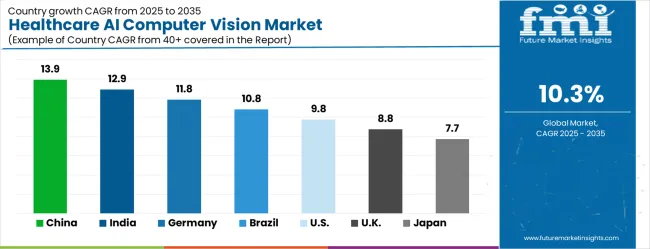
| Country | CAGR (2025-2035) |
|---|---|
| China | 13.9% |
| India | 12.9% |
| Germany | 11.8% |
| Brazil | 10.8% |
| USA | 9.8% |
| UK | 8.8% |
| Japan | 7.7% |
Regional synthesis reveals Asia-Pacific markets leading growth through healthcare modernization and medical infrastructure development, while European countries maintain steady expansion supported by medical technology advancement and EU healthcare standardization requirements. North American markets show moderate growth driven by clinical applications and medical technology integration trends.
China establishes market leadership through aggressive healthcare digitization programs and comprehensive medical infrastructure development, integrating advanced AI computer vision systems as standard components in diagnostic imaging and patient monitoring applications. The country's 13.9% CAGR through 2035 reflects government initiatives promoting AI healthcare technology and domestic medical technology capabilities that mandate advanced computer vision systems in hospital and clinic installations. Growth concentrates in major healthcare centers, including Beijing, Shanghai, and Guangzhou, where medical technology development showcases integrated AI diagnostic systems that appeal to domestic healthcare providers seeking advanced diagnostic capabilities and medical imaging enhancement applications.
Chinese manufacturers are developing cost-effective AI computer vision solutions that combine domestic production advantages with advanced features, including precision diagnostic algorithms and comprehensive medical imaging capabilities. Distribution channels through state healthcare procurement and medical equipment suppliers expand market access, while government funding for healthcare technology development supports adoption across diverse medical and diagnostic segments.
Strategic Market Indicators:
In New Delhi, Mumbai, and Bangalore, healthcare facilities and diagnostic centers are implementing advanced AI computer vision systems as standard equipment for medical imaging analysis and diagnostic support applications, driven by increasing healthcare spending and modernization programs that emphasize the use of AI-powered diagnostic capabilities. The market is projected to demonstrate a 12.9% CAGR through 2035, supported by government healthcare initiatives and medical infrastructure development programs that promote advanced AI diagnostic tools for hospitals and medical facilities. Indian healthcare providers are adopting AI computer vision systems that provide precise diagnostic assistance capabilities and medical imaging enhancement features, particularly appealing in rural healthcare regions where diagnostic accuracy represents critical operational requirements.
Market expansion benefits from growing healthcare technology capabilities and international technology transfer agreements that enable domestic development of advanced AI systems for medical and diagnostic applications. Technology adoption follows patterns established in healthcare IT, where diagnostic accuracy and regulatory compliance drive procurement decisions and operational deployment.
Market Intelligence Brief:
Germany's advanced healthcare technology market demonstrates sophisticated AI computer vision deployment with documented clinical effectiveness in hospital diagnostic departments and medical imaging centers through integration with existing healthcare systems and clinical infrastructure. The country leverages engineering expertise in medical technology and healthcare systems integration to maintain an 11.8% CAGR through 2035. Healthcare centers, including Munich, Berlin, and Hamburg, showcase premium installations where AI computer vision integrates with comprehensive hospital information systems and medical imaging platforms to optimize diagnostic accuracy and clinical workflow effectiveness.
German healthcare technology providers prioritize system reliability and EU regulatory compliance in AI computer vision development, creating demand for premium systems with advanced features, including clinical validation and integration with European healthcare standards. The market benefits from established healthcare industry infrastructure and willingness to invest in advanced diagnostic technologies that provide long-term clinical benefits and compliance with medical device regulations.
Market Intelligence Brief:
Brazil's market expansion benefits from diverse healthcare demand, including hospital modernization in São Paulo and Rio de Janeiro, public healthcare system upgrades, and government health programs that increasingly incorporate AI-powered diagnostic solutions for medical imaging applications. The country maintains a 10.8% CAGR through 2035, driven by rising healthcare awareness and increasing adoption of AI computer vision technology benefits, including precise diagnostic assistance and reduced clinical error capabilities.
Market dynamics focus on cost-effective AI computer vision solutions that balance advanced diagnostic features with affordability considerations important to Brazilian healthcare providers. Growing healthcare infrastructure creates sustained demand for modern diagnostic systems in new medical facilities and hospital equipment modernization projects.
Strategic Market Considerations:
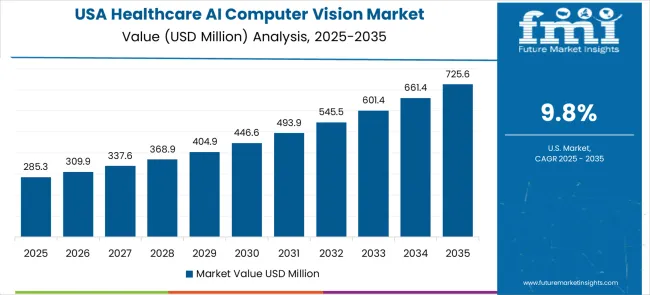
The USA market emphasizes advanced AI computer vision features, including precision diagnostic algorithms and integration with comprehensive hospital information systems that manage medical imaging, patient monitoring, and clinical decision support applications through unified healthcare platforms. The country is projected to show a 9.8% CAGR through 2035, driven by healthcare modernization under medical equipment upgrades and federal healthcare agency demand for reliable AI-powered diagnostic systems. American healthcare providers prioritize clinical effectiveness with AI computer vision, delivering consistent diagnostic assistance through advanced machine learning algorithms and regulatory compliance capabilities.
Technology deployment channels include major healthcare technology contractors, specialized medical equipment suppliers, and federal healthcare programs that support professional installation for complex hospital applications. Healthcare platform integration capabilities with established medical systems expand market appeal across diverse clinical requirements seeking diagnostic accuracy and regulatory compliance benefits.
Performance Metrics:
In London, Manchester, and other medical centers, British healthcare providers and diagnostic facilities are implementing advanced AI computer vision systems to enhance diagnostic capabilities and support clinical decision-making that aligns with NHS standards and medical device regulations. The UK market is expected to demonstrate sustained growth with an 8.8% CAGR through 2035, driven by healthcare modernization programs and medical equipment upgrades that emphasize advanced AI-powered diagnostic tools for hospital and clinic applications. British medical facilities are prioritizing AI computer vision systems that provide precise diagnostic assistance capabilities while maintaining compliance with medical device regulations and minimizing clinical error risks, particularly important in emergency departments and specialized medical applications.
Market expansion benefits from NHS procurement programs that mandate AI diagnostic capabilities in medical equipment specifications, creating sustained demand across the UK's healthcare sectors where clinical effectiveness and regulatory compliance represent critical requirements. The regulatory framework supports AI computer vision adoption through medical device standards and healthcare technology requirements that promote advanced diagnostic systems aligned with national healthcare capabilities.
Strategic Market Indicators:
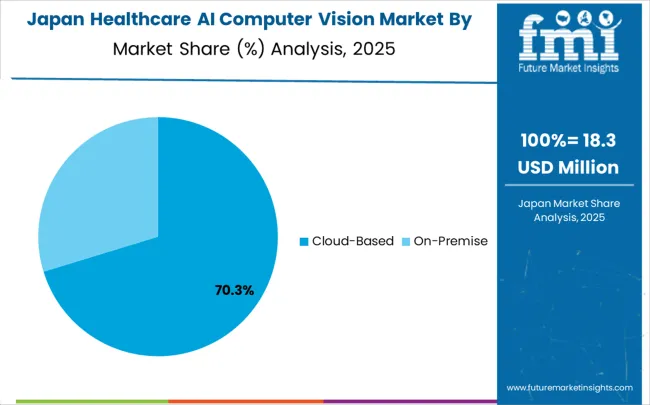
In Japan, the Healthcare AI Computer Vision market prioritizes Cloud-Based deployment systems, which capture the dominant share of hospital and medical facility installations through advanced features, including scalable processing capabilities and seamless integration with existing healthcare information technology infrastructure. Japanese healthcare providers emphasize reliability, clinical accuracy, and long-term operational excellence, creating demand for cloud-based systems that provide flexible deployment capabilities and adaptive processing control based on clinical requirements and diagnostic complexity scenarios. On-Premise systems maintain a secondary market position primarily in specialized applications and high-security medical installations where data locality requirements meet regulatory compliance without cloud connectivity features.
Market Characteristics:
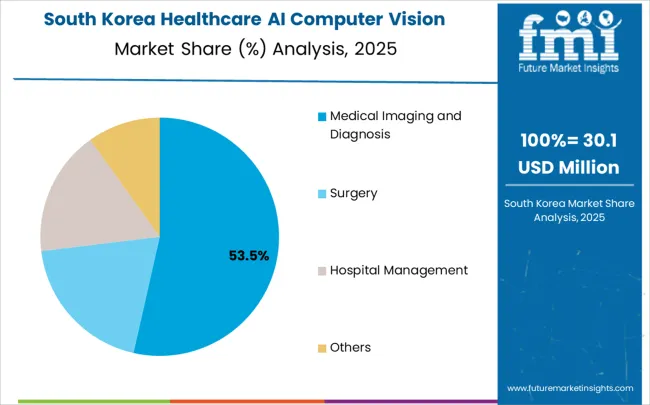
In South Korea, the market structure favors international healthcare technology companies, including NVIDIA, Microsoft, and Intel, which maintain dominant positions through comprehensive product portfolios and established medical procurement networks supporting both hospital systems and diagnostic facilities. These providers offer integrated solutions combining advanced AI computer vision systems with professional installation services and ongoing technical support that appeal to Korean healthcare providers seeking reliable AI-powered diagnostic systems. Local healthcare technology contractors and system integrators capture moderate market share by providing localized service capabilities and competitive pricing for standard medical installations. At the same time, domestic manufacturers focus on specialized applications and cost-effective solutions tailored to Korean healthcare characteristics.
Channel Insights:
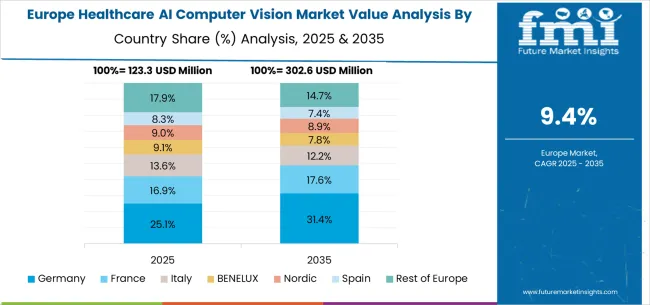
The Healthcare AI Computer Vision market in Europe is projected to grow from USD 125.4 million in 2025 to USD 334.2 million by 2035, registering a CAGR of 10.3% over the forecast period. Germany is expected to maintain its leadership position with a 26.8% market share in 2025, declining slightly to 25.4% by 2035, supported by its advanced healthcare infrastructure and major medical technology centers, including Munich and Berlin.
France follows with a 21.2% share in 2025, projected to reach 21.6% by 2035, driven by comprehensive healthcare digitization programs and medical technology development initiatives. The United Kingdom holds an 18.9% share in 2025, expected to maintain 18.7% by 2035 through specialized medical applications and NHS standardization requirements. Italy commands a 13.7% share, while Spain accounts for 9.8% in 2025. The Rest of Europe region is anticipated to gain momentum, expanding its collective share from 9.6% to 10.8% by 2035, attributed to increasing AI computer vision adoption in Nordic countries and emerging Eastern European healthcare systems implementing medical modernization programs.
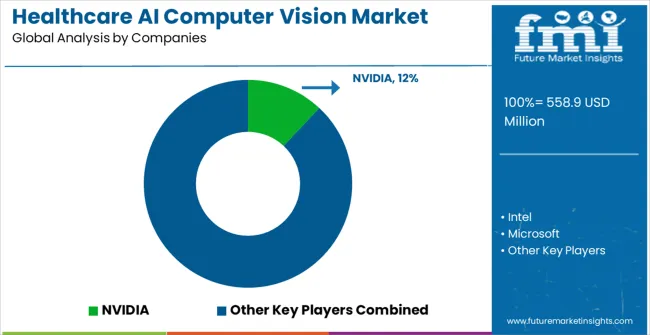
The Healthcare AI Computer Vision market operates with moderate concentration, featuring approximately 20-25 meaningful participants, where leading companies control roughly 55-60% of the global market share through established healthcare technology relationships and comprehensive AI platform portfolios. Competition emphasizes advanced diagnostic capabilities, system reliability, and healthcare platform integration rather than price-based rivalry.
Market Leaders encompass NVIDIA, Intel, Microsoft, Advanced Micro Devices, and Google, which maintain competitive advantages through extensive healthcare technology expertise, global technology contractor networks, and comprehensive system integration capabilities that create customer switching costs and support premium pricing. These companies leverage decades of AI technology experience and ongoing research investments to develop advanced AI computer vision systems with precision diagnostic algorithms and clinical validation features.
Technology Challengers include Basler AG, AiCure, iCAD, Thermo Fisher Scientific, and SenseTime, which compete through specialized healthcare AI focus and innovative diagnostic interfaces that appeal to medical customers seeking advanced diagnostic accuracy capabilities and clinical flexibility. These companies differentiate through rapid technology development cycles and specialized healthcare application focus.
Regional Specialists feature companies like KEYENCE, Assert AI, Artisight, LookDeep, and care.ai, which focus on specific geographic markets and specialized applications, including hospital management systems and integrated clinical platforms. Market dynamics favor participants that combine reliable AI algorithms with advanced diagnostic software, including precision medical imaging analysis and automatic clinical decision support capabilities. Competitive pressure intensifies as traditional healthcare technology contractors expand into AI diagnostic systems. At the same time, specialized computer vision companies challenge established players through innovative diagnostic solutions and cost-effective platforms targeting specialized medical segments.
| Item | Value |
|---|---|
| Quantitative Units | USD 558.9 million |
| Deployment Model | Cloud-Based, On-Premise |
| Application | Medical Imaging and Diagnosis, Surgery, Hospital Management, Others |
| Regions Covered | North America, Europe, Asia Pacific, Latin America, Middle East & Africa |
| Countries Covered | China, India, Germany, Brazil, the USA, the UK, Japan, and 25+ additional countries |
| Key Companies Profiled | NVIDIA, Intel, Microsoft, Advanced Micro Devices, Google, Basler AG, AiCure, iCAD, Thermo Fisher Scientific |
| Additional Attributes | Dollar sales by deployment model and application categories, regional adoption trends across North America, Europe, and Asia-Pacific, competitive landscape with healthcare technology providers and AI specialists, medical provider preferences for diagnostic accuracy and system reliability, integration with hospital information systems and clinical workflows, innovations in diagnostic algorithms and medical imaging analysis, and development of cloud-based solutions with enhanced scalability and accessibility capabilities. |
How big is the Healthcare AI computer vision market in 2025?
The global Healthcare AI computer vision market is valued at USD 558.9 million in 2025.
What will be the size of the healthcare AI computer vision market in 2035?
The size of the healthcare AI computer vision market is projected to reach USD 1,489.7 million by 2035.
How much will the healthcare AI computer vision market grow between 2025 and 2035?
The healthcare AI computer vision market is expected to grow at a 10.3% CAGR between 2025 and 2035.
What are the key deployment model segments in the Healthcare AI Computer Vision market?
The key deployment model segments in the Healthcare AI Computer Vision market are Cloud-Based and On-Premise.
Which application segment is expected to contribute a significant share to the healthcare AI computer vision market in 2025?
In terms of application, the medical imaging and diagnosis segment is set to command the dominant share in the healthcare AI computer vision market in 2025.
The global healthcare AI computer vision market is estimated to be valued at USD 558.9 million in 2025.
The market size for the healthcare AI computer vision market is projected to reach USD 1,489.7 million by 2035.
The healthcare AI computer vision market is expected to grow at a 10.3% CAGR between 2025 and 2035.
The key product types in healthcare AI computer vision market are cloud-based and on-premise.
In terms of application, medical imaging and diagnosis segment to command 52.1% share in the healthcare AI computer vision market in 2025.






Our Research Products

The "Full Research Suite" delivers actionable market intel, deep dives on markets or technologies, so clients act faster, cut risk, and unlock growth.

The Leaderboard benchmarks and ranks top vendors, classifying them as Established Leaders, Leading Challengers, or Disruptors & Challengers.

Locates where complements amplify value and substitutes erode it, forecasting net impact by horizon

We deliver granular, decision-grade intel: market sizing, 5-year forecasts, pricing, adoption, usage, revenue, and operational KPIs—plus competitor tracking, regulation, and value chains—across 60 countries broadly.

Spot the shifts before they hit your P&L. We track inflection points, adoption curves, pricing moves, and ecosystem plays to show where demand is heading, why it is changing, and what to do next across high-growth markets and disruptive tech

Real-time reads of user behavior. We track shifting priorities, perceptions of today’s and next-gen services, and provider experience, then pace how fast tech moves from trial to adoption, blending buyer, consumer, and channel inputs with social signals (#WhySwitch, #UX).

Partner with our analyst team to build a custom report designed around your business priorities. From analysing market trends to assessing competitors or crafting bespoke datasets, we tailor insights to your needs.
Supplier Intelligence
Discovery & Profiling
Capacity & Footprint
Performance & Risk
Compliance & Governance
Commercial Readiness
Who Supplies Whom
Scorecards & Shortlists
Playbooks & Docs
Category Intelligence
Definition & Scope
Demand & Use Cases
Cost Drivers
Market Structure
Supply Chain Map
Trade & Policy
Operating Norms
Deliverables
Buyer Intelligence
Account Basics
Spend & Scope
Procurement Model
Vendor Requirements
Terms & Policies
Entry Strategy
Pain Points & Triggers
Outputs
Pricing Analysis
Benchmarks
Trends
Should-Cost
Indexation
Landed Cost
Commercial Terms
Deliverables
Brand Analysis
Positioning & Value Prop
Share & Presence
Customer Evidence
Go-to-Market
Digital & Reputation
Compliance & Trust
KPIs & Gaps
Outputs
Full Research Suite comprises of:
Market outlook & trends analysis
Interviews & case studies
Strategic recommendations
Vendor profiles & capabilities analysis
5-year forecasts
8 regions and 60+ country-level data splits
Market segment data splits
12 months of continuous data updates
DELIVERED AS:
PDF EXCEL ONLINE
Computer Vision in Healthcare Market Size and Share Forecast Outlook 2025 to 2035
Brain-Computer Interface Implant Market Analysis Size and Share Forecast Outlook 2025 to 2035
Computer Aided Facility Management (CAFM) Market Size and Share Forecast Outlook 2025 to 2035
Computer-aided Design (CAD) Market Analysis - Size, Share, & Forecast Outlook 2025 to 2035
Computer-aided Engineering Market Analysis - Size, Share, and Forecast 2025 to 2035
Computer Vision Market Insights – Trends & Forecast 2025 to 2035
Computer Aided Trauma Fixators Market
Healthcare Air Purifier Market Size and Share Forecast Outlook 2025 to 2035
Computerized Maintenance Management Systems (CMMS) Market Trends – Size, Share & Growth 2025–2035
Healthcare Cold Chain Logistics Market Size and Share Forecast Outlook 2025 to 2035
Healthcare Mobile Computers Market Size and Share Forecast Outlook 2025 to 2035
Healthcare Regulatory Affairs Outsourcing Market Size and Share Forecast Outlook 2025 to 2035
Conversational AI in Healthcare Market Size and Share Forecast Outlook 2025 to 2035
AI Code Assistant Market Size and Share Forecast Outlook 2025 to 2035
AI-Based Data Observability Software Market Size and Share Forecast Outlook 2025 to 2035
Air Fryer Paper Liners Market Size and Share Forecast Outlook 2025 to 2035
Air Struts Market Size and Share Forecast Outlook 2025 to 2035
AI-powered Wealth Management Solution Market Size and Share Forecast Outlook 2025 to 2035
Airless Paint Spray System Market Size and Share Forecast Outlook 2025 to 2035
AI Powered Software Testing Tool Market Size and Share Forecast Outlook 2025 to 2035

Thank you!
You will receive an email from our Business Development Manager. Please be sure to check your SPAM/JUNK folder too.
Chat With
MaRIA